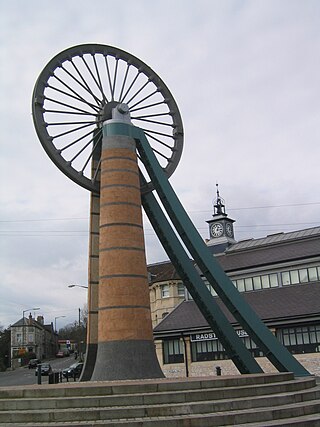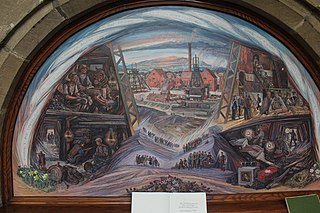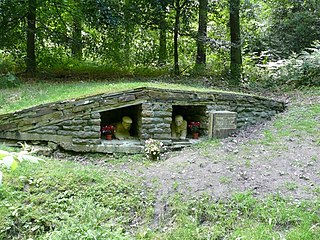
A pit pony, otherwise known as a mining horse, [1] was a horse, pony or mule commonly used underground in mines from the mid-18th until the mid-20th century. The term "pony" was sometimes broadly applied to any equine working underground. [2] [1]

A pit pony, otherwise known as a mining horse, [1] was a horse, pony or mule commonly used underground in mines from the mid-18th until the mid-20th century. The term "pony" was sometimes broadly applied to any equine working underground. [2] [1]
The first known recorded use of ponies underground in Great Britain was in the Durham coalfield in 1750. Following the drowning deaths of 26 children [3] when the Huskar Colliery in Silkstone flooded on 4 July 1838, "A report was published in The Times , and the wider British public learned for the first time that women and children worked in the mines. There was a public outcry, led by politician and reformer Anthony Ashley Cooper, later Lord Shaftesbury", [4] who then introduced the Mines and Collieries Act 1842 to Parliament which barred women, girls and boys under 10 (later amended to 13) from working underground, leading to the widespread use of horses and ponies in mining in England, though child labour lingered on to varying extents until finally eliminated by a variety of factors including further laws, improved inspection regimes, and changing economics. [5]
In the United States, mules outnumbered ponies in mines. [6] The use of ponies was never common in the US, though ponies were used in Appalachian coal fields in the mid-20th century. [7]
The British Coal Mines Regulation Act 1887 (50 & 51 Vict. c. 58) presented the first national legislation to protect horses working underground. Due to pressure from the National Equine Defense League (formerly the Pit Ponies' Protection Society) founded in 1908 by animal and human rights advocate Francis Albert Cox (24 June 1862 – 25 May 1920) [8] – and the Scottish Society to Promote Kindness to Pit Ponies; in 1911, a royal commission report was published, detailing conditions, which resulted in protective legislation.
In 1904, the president of the Association for the Prevention of Cruelty to Pit Ponies, Countess Maud Fitzwilliam, daughter of Lawrence Dundas, 1st Marquess of Zetland, awarded a young Elsecar Collieries mine worker, John William Bell of Wentworth, the Fitzwilliam Medal for Kindness for an act of bravery that saved the life of his equine workmate. Bell's story of staying behind while his human workmates were able to escape through a small opening, to ensure that the pony would have a chance of rescue, became a successful tool for the Countess in promoting pit pony rights. [9] Bell died on 27 March 1910, when he was hit by falling rock at the Oakenshaw mine while trying to aid another miner whose hand putter's tub had become loose. [10]
In 1911, Sir Harry Lauder became an outspoken advocate, "pleading the cause of the poor pit ponies" to Sir Winston Churchill, when introduced to him at the House of Commons, reporting to the Tamworth Herald that he "could talk for hours about my wee four-footed friends of the mine. But I think I convinced him that the time has now arrived when something should be done by the law of the land to improve the lot and working conditions of the patient, equine slaves who assist so materially in carrying on the great mining industry of this country." [11]
At the peak of this practice in 1913, there were 70,000 ponies underground in Britain. In later years, mechanical haulage was introduced on the main underground roads replacing pony hauls, and ponies tended to be confined to the shorter runs from coal face to main road (known in North East England as "putting") which were more difficult to mechanise. In 1984 there were still 55 ponies in use with the National Coal Board in Britain, chiefly at the modern pit in Ellington, Northumberland. When Ellington closed for the first time in 1994, four pit ponies were brought out (no ponies were used there during the RJB Mining era). Of the four, two went to the National Coal Mining Museum for England at Caphouse and two went to Newcastle Cat and Dog Shelter. [12] The last surviving pony was Tony who died in 2011 aged 40 at the Newcastle Cat and Dog Shelter. [12]
Probably the last colliery horse to work underground in a British coal mine, "Robbie", was retired from Pant y Gasseg, near Pontypool, in May 1999. [13] The last pony mine in the US, located near Centerville, Iowa, closed in 1971. [7] The last pit ponies used in Australia, Wharrier and Mr Ed of the Collinsville Coal's No 2 Mine in Queensland, were retired in 1990. [14]
Larger horses, such as varieties of Cleveland Bay, could be used on higher underground roadways, but on many duties small ponies no more than 12 hands (48 inches, 122 cm) high were needed. Shetlands were a breed commonly used because of their small size, but Welsh, Russian, Devonshire (Dartmoor) and Cornish ponies also saw extensive use in England. [2] In the interwar period, ponies were imported into Britain from the Faroe Islands, Iceland and the United States. Geldings and stallions only were used. Donkeys were also used in the late 19th century, and in the United States, large numbers of mules were used. [6] Regardless of breed, typical mining ponies were low set, heavy bodied and heavy limbed with plenty of bone and substance, low-headed and sure-footed. Under the British Coal Mines Act 1911 (1 & 2 Geo. 5. c. 50), ponies had to be four years old and work ready (shod and vet checked) before going underground. [15] They could work until their twenties.[ citation needed ]

In shaft mines, ponies were normally stabled underground [16] and fed on a diet with a high proportion of chopped hay and maize, coming to the surface only during the colliery's annual holiday. In slope and drift mines, the stables were usually on the surface near the mine entrance. [17]
Typically, they would work an eight-hour shift each day, during which they might haul 30 tons of coal in tubs on the underground mine railway. One 1911 writer estimated that the average working life of coal mining mules was only 3+1⁄2 years, where 20-year working lives were common on the surface. [16] Recollections differ on how well the ponies were cared for in earlier years.

Pit ponies are commemorated by a 200 metres (660 ft) artwork, Sultan, created between 1996 and 1999 by Mike Petts, using 60,000 tons of coal shale waste, covered with living grass, in a country park on the site of the former Penallta Colliery, north of Caerphilly, Wales. [18] The artwork was named by local people, after one of the last pit ponies from the area, which was still living at the time. [18]

Elsecar is a village in the Metropolitan Borough of Barnsley in South Yorkshire, England. It is near to Jump and Wentworth, it is also 2 miles (3.2 km) south of Hoyland, 6 miles (9.7 km) south of Barnsley and 8 miles (13 km) north-east of Sheffield. Elsecar falls within the Barnsley Metropolitan Borough Ward of Hoyland Milton.

The South Wales Coalfield extends across Pembrokeshire, Carmarthenshire, Swansea, Neath Port Talbot, Bridgend, Rhondda Cynon Taf, Merthyr Tydfil, Caerphilly, Blaenau Gwent and Torfaen. It is rich in coal deposits, especially in the South Wales Valleys.

Mine rescue or mines rescue is the specialised job of rescuing miners and others who have become trapped or injured in underground mines because of mining accidents, roof falls or floods and disasters such as explosions.

The Somerset Coalfield in northern Somerset, England is an area where coal was mined from the 15th century until 1973. It is part of a larger coalfield which stretched into southern Gloucestershire. The Somerset coalfield stretched from Cromhall in the north to the Mendip Hills in the south, and from Bath in the east to Nailsea in the west, a total area of about 240 square miles (622 km2). Most of the pits on the coalfield were concentrated in the Cam Brook, Wellow Brook and Nettlebridge Valleys and around Radstock and Farrington Gurney. The pits were grouped geographically, with clusters of pits close together working the same coal seams often under the same ownership. Many pits shared the trackways and tramways which connected them to the Somerset Coal Canal or railways for distribution.
The Elsecar Collieries were the coal mines sunk in and around Elsecar, a small village to the south of Barnsley in what is now South Yorkshire, but was traditionally in the West Riding of Yorkshire.
The South Yorkshire Coalfield is so named from its position within Yorkshire. It covers most of South Yorkshire, West Yorkshire and a small part of North Yorkshire. The exposed coalfield outcrops in the Pennine foothills and dips under Permian rocks in the east. Its most famous coal seam is the Barnsley Bed. Coal has been mined from shallow seams and outcrops since medieval times and possibly earlier.

Ladyshore Colliery, originally named Back o' th Barn, was situated on the Irwell Valley fault on the Manchester Coalfield in Little Lever, then in the historic county of Lancashire, England. Founded by Thomas Fletcher Senior, the colliery opened in the 1830s and mined several types of coal. It became infamous as a result of the owners' stand against the use of safety lamps in the mines. Women and children worked in the mines, under poor conditions.

Chatterley Whitfield Colliery is a disused coal mine on the outskirts of Chell, Staffordshire in Stoke on Trent, England. It was the largest mine working the North Staffordshire Coalfield and was the first colliery in the UK to produce one million tons of saleable coal in a year.
Albion Colliery was a coal mine in South Wales Valleys, located in the village of Cilfynydd, one mile north of Pontypridd.

Gresford Colliery was a coal mine located a mile from the North Wales village of Gresford, near Wrexham.

Coal mining in the United Kingdom dates back to Roman times and occurred in many different parts of the country. Britain's coalfields are associated with Northumberland and Durham, North and South Wales, Yorkshire, the Scottish Central Belt, Lancashire, Cumbria, the East and West Midlands and Kent. After 1972, coal mining quickly collapsed and had practically disappeared by the 21st century. The consumption of coal—mostly for electricity—fell from 157 million tonnes in 1970 to 587,000 tonnes in 2023 Employment in coal mines fell from a peak of 1,191,000 in 1920 to 695,000 in 1956, 247,000 in 1976, 44,000 in 1993, 2,000 in 2015, and to 360 in 2022.

The Lancashire Coalfield in North West England was an important British coalfield. Its coal seams were formed from the vegetation of tropical swampy forests in the Carboniferous period over 300 million years ago.

A mine railway, sometimes pit railway, is a railway constructed to carry materials and workers in and out of a mine. Materials transported typically include ore, coal and overburden. It is little remembered, but the mix of heavy and bulky materials which had to be hauled into and out of mines gave rise to the first several generations of railways, at first made of wooden rails, but eventually adding protective iron, steam locomotion by fixed engines and the earliest commercial steam locomotives, all in and around the works around mines.
Manchester Collieries was a coal mining company with headquarters in Walkden formed from a group of independent companies operating on the Manchester Coalfield in 1929. The Mining Industry Act of 1926 attempted to stem the post-war decline in coal mining and encourage independent companies to merge in order to modernise and better survive the economic conditions of the day. Robert Burrows of the Atherton company Fletcher Burrows proposed a merger of several independent companies operating to the west of Manchester. The merger was agreed and took place in March 1929.

Ellington Colliery, was a coal mine situated to the south of the village of Ellington in Northumberland, England. The colliery was the last deep coal mine in the north east of England. At one time, the deepest part of the mine was 800 metres (2,600 ft) and it extended 15 miles (24 km) under the North Sea. During the 1980s, the pit was known as the biggest undersea mine in the world and produced 69% of the mined coal in Northumberland.
This is a partial glossary of coal mining terminology commonly used in the coalfields of the United Kingdom. Some words were in use throughout the coalfields, some are historic and some are local to the different British coalfields.

Huskar Pit was a coal mine on the South Yorkshire Coalfield, sunk to work the Silkstone seam. It was located in Nabs Wood, outside the village of Silkstone Common, in the then West Riding of Yorkshire. It was connected to the Barnsley Canal by the Silkstone Waggonway. Huskar was the scene of a notorious pit disaster in 4 July 1838.

The coal industry in Wales played an important role in the Industrial Revolution in Wales. Coal mining in Wales expanded in the 18th century to provide fuel for the blast furnaces of the iron and copper industries that were expanding in southern Wales. The industry had reached large proportions by the end of that century, and then further expanded to supply steam-coal for the steam vessels that were beginning to trade around the world. The Cardiff Coal Exchange set the world price for steam-coal and Cardiff became a major coal-exporting port. The South Wales Coalfield was at its peak in 1913 and was one of the largest coalfields in the world. It remained the largest coalfield in Britain until 1925. The supply of coal dwindled, and pits closed in spite of a UK-wide strike against closures. Aberpergwm Colliery is the last deep mine in Wales.

The Coal Mines Act 1911 amended and consolidated legislation in the United Kingdom related to collieries. A series of mine disasters in the 19th and early-20th centuries had led to commissions of enquiry and legislation to improve mining safety. The 1911 Act, sponsored by Winston Churchill, was passed by the Liberal government of H. H. Asquith. It built on earlier regulations and provided for many improvement to safety and other aspects of the coal mining industry. An important aspect was that mine owners were required to ensure there were mines rescue stations near each colliery with equipped and trained staff. Although amended several times, it was the main legislation governing coal mining for many years.
Kajora Area is one of the 14 operational areas of Eastern Coalfields Limited located in Durgapur subdivision of Paschim Bardhaman district in the state of West Bengal, India.